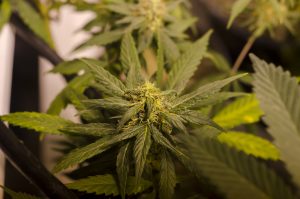This could have huge ramifications for the United States: It will reduce the burden on the criminal justice system, it could free up budgets currently invested in the ineffective war on drugs, it could pave the way to more research, and it could ultimately contribute to further rescheduling and the development of regulations that would safely legalise and tax marijuana. Right now, advocates are in a froth over the possibilities.
Reefer madness
The DEA has a strange fixation on marijuana, and has historically resisted strenuous efforts to reevaluate its stance on the substance. Cannabis has been illegal since the 1920s, when it became extremely popular as a result of Prohibition, and a decade later, hemp production was outlawed as well, despite the fact that hemp is simply a fiber, not a drug. Nearly half of all drug arrests every year are marijuana-related, even as individual states and cities have begun breaking with the DEA when it comes to marijuana policy — many are tired of the expense and time consumption associated with managing marijuana investigations and prosecutions.
However, ever since 1970, it remains classified under Schedule I, the most stringent rating set by the DEA, which rules the handful of drugs classified as such to have no medical use and a high potential for abuse. Schedule II drugs have a potential for abuse and dependence, and are considered dangerous, but medically useful — many are prescription opioids used in pain management, and notably, nearly 20,000 people die of opioid doses every year. To date, no deaths have been definitively attributed to marijuana.
Schedule III drugs come with mild addictive tendencies but a variety of medical applications — certain steroid and pain management pain medications fall under this category. Drugs with a very low risk of abuse and dependence, like many anxiety medications and mild sedatives, fall under Schedule IV, while Schedule V drugs are of even lesser concern. Marijuana, which causes no known deaths and doesn’t appear to have addictive properties, is considered more dangerous than drugs like dilaudid (Schedule II). At most, it should be a schedule V compound.
The aggressive scheduling of the drug means that people involved in any stage of growing, handling, selling, and holding marijuana can potentially run afoul of federal law — and that includes medical researchers who want to learn more about cannabis and its effects on the brain. The very research that could determine the best scheduling for the drug isn’t possible to conduct because of the official limitations on access — the DEA permits only a small number of scientists to work with the drug, and they all have to obtain it through the same farm.
Criminalisation doesn’t work
Yet, many claim that marijuana has medical applications, particularly for cancer patients and those with chronic pain conditions. Other argue that it should be fully legalised for all uses, including recreational ones — some advocate for full legalisation or decriminalisation of all drugs, which would make it possible to regulate, monitor, and tax them. Decriminalising marijuana would mean that any criminal penalties for the drug would be lifted — people would no longer face fines, jail, and other consequences. Legalisation would proactively strike criminal laws from the books and create a possible framework for better regulation.

Marijuana advocates have fought tirelessly for change, and the conflict between state and federal law is a constant tension. In states with varying degrees of legalisation and decriminalisation, dispensaries and other organisations that work with and around the drug may not face penalties from the state, but could still be charged under federal law. This creates a highly unpredictable and capricious environment around marijuana, and it contributes to a variety of social issues, including price volatility, unjust incarceration, environmental problems caused by establishing grows in remote areas, difficulty with federal taxes, the inability to enter the banking system, and higher crime rates.
It also deprives the government of opportunities. Regulating and taxing marijuana would make the drug less expensive and bring in significant tax revenues, a major concern in states struggling with budget overruns. Moreover, it would allow firms with an interest in marijuana to initiate product development — a particular issue in Silicon Valley, where some startups and venture capitalists are waiting for the green light before they sink their resources into developing marijuana-related products that would boost California’s economy and create jobs. Growers and others in the supply chain also face uncertainties, not knowing if they’ll lose their crops, face arrest, or be profiled by federal officials.
Rescheduling is the wave of the future
Rescheduling doesn’t legalise, or possibly even decriminalise, marijuana. It may result in a situation where patients are able to receive it under very set conditions, just as they can access other controlled substances. It would also open up the field to medical research, which will provide valuable insights into the applications of the drug. States could finally bring their laws into alignment with those of the federal government, creating a cohesive and functional drug policy, and the drug industry would undergo fundamental shifts.
One short-term consequence will revolve around the racial and criminal injustices surrounding the drug. People of colour in the United States are profiled by law enforcement, and they’re often victims not just of marijuana arrests, but sentencing disparities. A generation of people of colour — especially young Black men — are being torn from their communities, destroying families and community cohesion. They’re also entering the revolving door of the criminal justice system, which tends to churn victims ’round and ’round without any clear stopping point. Depending on how the drug is rescheduled and regulated — if it is — people of colour could recover important social advantages, like opportunities to lift themselves from poverty.

Public health researchers, government officials, and advocates have all been pleading with the DEA to reconsider its treatment of the drug. Ranking officials in the DEA have historically taken dismissive stances on medical marijuana, let alone recreational uses of the drug, and these could portend an opinion that won’t satisfy some advocates — or perhaps these officials will reevaluate their positions in light of the evidence that they’re being presented with as they discuss the situation.
It seems highly probable that the DEA will be taking a new stance given changes among social, political, and public policy trends surrounding marijuana — members of the public have a very different opinion of the drug than they once did, and they’re ready for the DEA to catch up. If it does, the result will be a fundamental change in the American landscape, and one that some people argue is long due.
Photo: tanjila ahmed/Creative Commons

